

Collaborative Brainstorming & Group Decision-Making. All You Need To Know About Customer Journey Mapping. Advertisement Today, too many websites are still inaccessible.
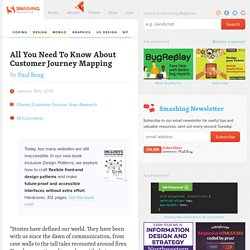
In our new book Inclusive Design Patterns, we explore how to craft flexible front-end design patterns and make future-proof and accessible interfaces without extra effort. Hardcover, 312 pages. Get the book now! “Stories have defined our world. Francisco Inchauste wrote those words1 on this article back in 2010. Further Reading on SmashingMag: Link But storytelling is not just a tool to engage users. Most organizations are reasonably good at gathering data on their users. What Is A Customer Journey Map? A customer journey map tells the story of the customer’s experience: from initial contact, through the process of engagement and into a long-term relationship. It may focus on a particular part of the story or give an overview of the entire experience.
It often provides a sense of the customer’s greater motivation. CX Journey Mapping Toolkit — Designing CX. Once you feel comfortable with your understanding of the CX Journey Mapping process, you can then begin to move towards holding a customized session at your organization. below are the recommended steps to follow to prepare and run a CXJM Design Session.
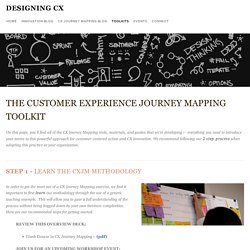
The Elements of a Successful Sales Plan. Q: I'm developing a sales plan for my business.
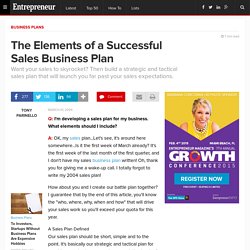
What elements should I include? A: OK, my sales plan...Let's see, it's around here somewhere...Is it the first week of March already? It's the first week of the last month of the first quarter, and I don't have my sales business plan written! Oh, thank you for giving me a wake-up call. I totally forgot to write my 2004 sales plan! How about you and I create our battle plan together? A Sales Plan DefinedOur sales plan should be short, simple and to the point. How to Write a Sales Plan: 8 Steps. The 10 things I have learnt about Agile Product Delivery. I have a confession.
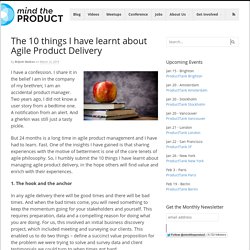
I share it in the belief I am in the company of my brethren; I am an accidental product manager. Two years ago, I did not know a user story from a bedtime one. A notification from an alert. And a gherkin was still just a tasty pickle. But 24 months is a long time in agile product management and I have had to learn. 1. In any agile delivery there will be good times and there will be bad times.
The other (not to be overlooked) benefit was that it enabled us to take reduce resistance from nay-sayers. 2. After university, I fell into a role in Financial Services and spent most of my career working at the intersection of strategy, technology and operations. I once commented to a friend that for an MBA grad like me, this was the ideal job. 3. 4. For over a year I managed the interaction between an off-shore ‘front-end’ development team and an on-shore ’back-end’ team. 5.
Take responsibility for requirement creation and only create ones that an end-user could understand. New Product Development. The Seven Deadly Sins of Product Planning. Posted by Marty Cagan on March 9, 2009 Tags: product portfolio planning, product discovery Product planning is a big topic that many product organizations struggle with.
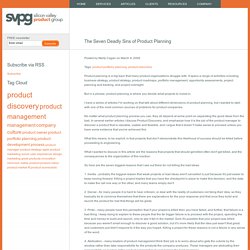
It spans a range of activities including business strategy, product strategy, product roadmaps, portfolio management, opportunity assessments, project planning and tracking, and project oversight. But in a phrase, product planning is where you decide what projects to invest in. I have a series of articles I¹m working on that talk about different dimensions of product planning, but I wanted to start with one of the most common sources of problems for product companies. No matter what product planning process you use, they all depend at some point on separating the good ideas from the bad. What this means, to be explicit, is that projects that don¹t demonstrate this likelihood of success should be killed before proceeding to engineering. So here are the seven biggest reasons that I see out there for not killing the bad ideas: Project Manager vs Product Manager : Brainmates – Boosting People and Product Performance. One of the key challenges that we hear when we talk to PRODUCT Managers is that they are often expected to perform the role of PROJECT Manager for some or all of the delivery of their product to the marketplace.

On the “Brainmates – Product Management People” LinkedIn group, Tom Adler posted the following question to find out the difference: “I know that Product Managers are often asked to be Project Managers. Are Project Managers often asked to be Product Managers?”. This generated a lot of reactions, mostly questioning whether one person can effectively fulfil both roles at the same time. Here hare a few of the comments posted: Scot Sehlhorst:“For me, the difference is simple.
At Brainmates we treat these two roles as fundamentally different, yet interrelated roles.
Creating a Strategic Product Plan. Practical Training.
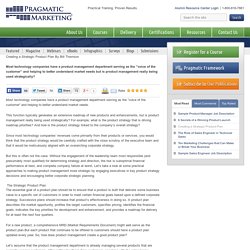
Proven Results. Alumni Resource Center Login 1-800-816-7861 Creating a Strategic Product Plan By Bill Thomson Most technology companies have a product management department serving as the “voice of the customer” and helping to better understand market needs but is product management really being used strategically?
Rate Most technology companies have a product management department serving as the “voice of the customer” and helping to better understand market needs. This function typically generates an extensive roadmap of new products and enhancements, but is product management really being used strategically? Since most technology companies’ revenues come primarily from their products or services, you would think that the product strategy would be carefully crafted with the close scrutiny of the executive team and that it would be meticulously aligned with an overarching corporate strategy.
But this is often not the case.